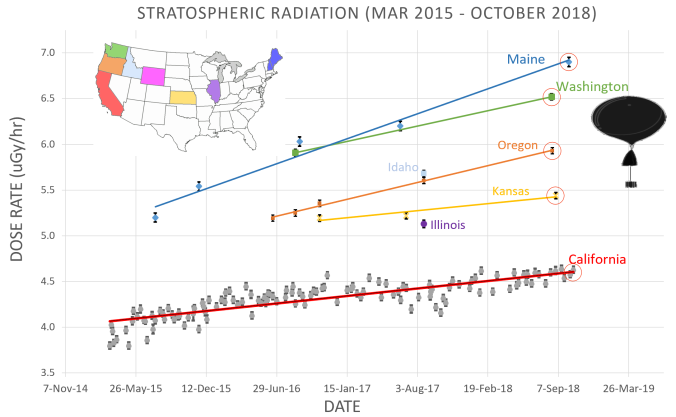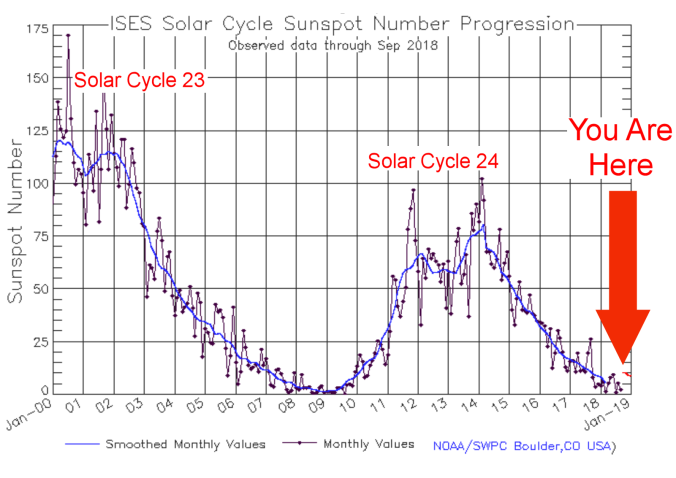
Since 2015, we have been monitoring X-rays, gamma-rays and neutrons in the stratosphere-mainly over central California, but also in a dozen other states (NV, OR, WA, ID, WY, KS, NE, MO, IL, ME, NH, VT). Everywhere we have been there is an upward trend in radiation-ranging from +20% in central California to +33% in Maine. The latest points, circled in red, were gathered during a ballooning campaign in August-October 2018.
How does Solar Minimum boost radiation? The answer lies in the yin-yang relationship between cosmic rays and solar activity. Cosmic rays are the subatomic debris of exploding stars and other violent events. They come at us from all directions, 24/7. Normally, the sun's magnetic field and solar wind hold cosmic rays at bay-but during Solar Minimum these defenses weaken. Deep-space radiation surges into the solar system.
Cosmic rays crashing into our planet's atmosphere produce a spray of secondary particles and photons. That secondary spray is what we measure. Each balloon flight, which typically reaches an altitude greater than 100,00o feet, gives us a complete profile of radiation from ground level to the stratosphere. Our sensors sample energies between 10 keV and 20 MeV, spanning the range of medical X-ray machines, airport security devices, and "killer electrons" in Earth's radiation belts.
Who cares? For starters, anyone who flies. Cosmic radiation at aviation altitudes is typically 50 times that of natural sources at sea level. Pilots are classified as occupational radiation workers by the International Commission on Radiological Protection (ICRP) and, according to a recent study from researchers at the Harvard School of Public Health, flight attendants face an elevated risk of cancer compared to members of the general population. They listed cosmic rays as one of several risk factors. Weather and climate may also be affected, with some research linking cosmic rays to to the formation of clouds and lightning. Finally, there are studies (one recently published in Nature) asserting that heart rate variability and cardiac arrhythmias are affected by cosmic rays in some populations. If true, it means the effects reach all the way to the ground.
As 2018 comes to an end, Solar Minimum appears to be just getting started. Cosmic rays could continue to increase for years to come, so stay tuned.




Comment: By now it is well documented that our Sun is going quiet, Earth's magnetic field is weakening and the planets within our solar system are showing serious signs of change.
See also:
- The Golden Age, Psychopathy and the Sixth Extinction
- Sott Exclusive: Nemesis, not 'Nibiru' - Clarifying mainstream reports about 'a large ninth planet' that periodically sends comets our way
- Science catches up with reality: Newly-discovered distant planet bolsters evidence for 'Planet X'
- Cosmic climate change: Is the cause of all this extreme weather to be found in outer space?
- Cosmic rays increased 12% this year plus an awesome 'diamond dust' sun halo sighted in Montana (PHOTOS)
- The next big 'space weather' event poses an astronomical risk to modern man
And for more, check out SOTT radio's: Behind the Headlines: Earth changes in an electric universe: Is climate change really man-made? as well as SOTT's monthly documentary: